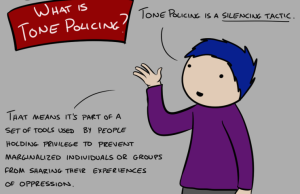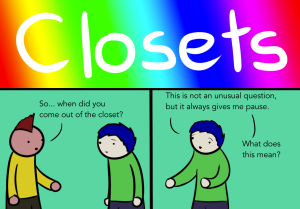Lately, the orgasms experienced by people with vaginas have become a popular topic of discussion within feminism. And that’s awesome – because a lot of myths spread about them are worth debunking.
But unfortunately, feminist dialogues too often focus on debunking a few select myths while ignoring or even perpetuating others.
If you’ve been reading feminist blogs or watching feminist videos, for example, you’ve probably heard people challenge the idea that women’s orgasms are optional while men’s are obligatory. You’ve also probably heard people call bullshit on the notion that you can just ignore the clitoris.
Yet when it comes to other myths about vaginal orgasms, old habits die hard.
(To be clear, when I say “vaginal orgasms,” I’m referring to orgasms experienced by those with vaginas, not orgasms that originate from inside the vagina – more on those later.)
For example, it’s common to hear women’s magazines celebrate the vaginal orgasm as its own class of orgasm, full of emotion and complexity and other stereotypically feminine attributes.
“You’re over there with your eyes glazed over going on a spiritual journey that forever changes you,” Frank Kobola writes of cis women’s orgasms in an article published in Cosmo and Marie Claire.
“The female orgasm is a bit, say, more nuanced than the male orgasm… a male orgasm is, well, pretty upfront,” Olivia Gatwood writes on the feminist site Bustle.
No doubt, articles like these are trying to give women confidence and help them enjoy their bodies. And they may very well do that. But they also exoticize the hell out of women, not to mention conflate gender identity with genitals and other biological factors.
Descriptive statements about the intensity, difficulty, and distinctiveness of the vaginal orgasm can become prescriptive, making people feel like they’re not functioning properly if they don’t have the type of vaginal orgasm feminists are celebrating.
For this reason, these beliefs are just as capable of impeding sexual pleasure and confidence as the myths feminists more typically combat. And that’s why they should be challenged just as much.
So here are some specific myths that feminists often spread about vaginal orgasms – and why they actually undermine feminism.
Myth #1: There Is a Universal ‘Female Orgasm’
Many feminists like to talk about the “female orgasm.” Hell, there’s even a book and sex-ed program called “I Love Female Orgasm.”
The issue with this language? For one thing, it makes it sound like everyone who identifies as female has the same genitals. And they don’t. Some people who identify as women have vaginas, some have penises, and some are intersex.
And even if we’re only discussing those with vaginas, there still is no universal orgasm because different vaginas orgasm differently.
In fact, even if you’re just talking about one person, sexologist Carol Queen pointed out, “there are orgasms that come from many kinds of stimulation and erotic experience.” Two women may experience an orgasm differently, and one woman may experience her own differently from day to day.
Talking about the “female orgasm” excludes those who don’t experience this supposedly universal phenomenon. Feminist discussions should be inclusive, and that means acknowledging everyone’s differences.
The phrase “female orgasm” not only creates a false sense of sameness among women, but also creates a false sense of difference between women and everyone else. Often, the “female orgasm” is contrasted with the “male orgasm,” erasing those who don’t identify as male or female and masking similarities between people of different genders.
“Orgasm is experienced in the brain, not the body part that was stimulated to get you there,” Queen explained. So people with different body parts and gender identities may have more in common than the typical language around orgasms would suggest.
Myth #2: All People with Vaginas Are Multi-Orgasmic
“You know that if you have one, you stick around for more,” Tracie Egan Morrissey writes of women on the women’s site Jezebel. “Orgasms from masturbating are like Payless shoes: Once you get the first pair, you get the second for next to nothing.”
This analogy is amusing, but it’s false. Most women don’t actually have multiple orgasms.
According to the 2015 OMGYES Study of Women’s Sexual Pleasure, which was conducted at Indiana University with 1,055 women, only 47% of women with vaginas experience multiple orgasms. So, when feminists suggest that all people with vaginas know what multiple orgasms are like, they’re excluding a yikes-ton of people.
Even more insidious is when feminists imply that multiple orgasms make women’s sexuality empowering. This is not only cissexist, but also implies that women without multiple orgasms are somehow less empowered.
“Technically, the female sexual organs are what the older religions feared as ‘the insatiable cunt,’” Naomi Wolf writes in The Beauty Myth. “Capable of multiple orgasm, continual orgasm, a sharp and breath-taking clitoral orgasm, an orgasm seemingly centerd in the vagina that is emotionally overwhelming, orgasm from having the breasts stroked, and of endless variations of all those responses combined, women’s capacity for genital pleasure is theoretically inexhaustible.”
Look – I get the appeal of the idea that the vagina is insatiable. After all, it reverses the mainstream belief that women don’t have strong sexual appetites.
But we shouldn’t need to have insatiable vaginas to be sexually empowered. We shouldn’t even need strong sexual appetites. Being sexually empowered just means conducting your sex life in the way that feels best to you.
As one of the many women who does not have multiple orgasms, I felt abnormal for a while. I felt like I was missing out on a special part of having a vagina – on something that made me sexual.
The notion that all people with vaginas are multi-orgasmic also put pressure on my partners to give me something my body just didn’t do. Teaching people to expect their partners’ bodies to do something they may or may not do causes unnecessary tension.
The best way to be an attentive sexual partner is to treat each person on a case-by-case basis. Some people can have multiple orgasms, some can only have one, and some can’t have any. The important thing is not whether you can help your partner’s body do a particular thing, but whether you’re respecting what they want to do.
Myth #3: People with Vaginas Never Have Refractory Periods
One way people often exoticize women, particularly lesbians, is by talking about how sex is never-ending for them.
First things first: The idea that sex is over once someone with a penis, usually a man in this assumption, has an orgasm is patriarchal as hell.
Secondly, the notion that people with vaginas (once again, usually conflated with women in this narrative) do not get tired of sex is biologically false.
Many vaginas get too sensitive or stop responding after one orgasm – or two, or some number other than infinity.
“While some women have no refractory period and can go on with stimulation right after an orgasm, many women need a little break before they can start seeking orgasm again,” said Queen.
As an anonymous writer points out in The Frisky, there’s a double standard in heterosexual relationships: After a woman has an orgasm, she’s expected to keep going until the man is satisfied. After a man has an orgasm, sex is supposed to be over.
Claiming that people with vaginas don’t have refractory periods and conflating these people with women perpetuates this sexist convention. It also, as I mentioned, perpetuates the stereotype that women’s sexuality is fundamentally different and that lesbian sexuality in particular is exotic.
This viral cartoon classifying “hetero sex” and “lesbian sex” into two patterns represented on graphs sums up the latter idea. The image makes lesbian sex look extremely weird and different, with features including “orgasm 1/7” and “time traveling.”
Jokes like these not only perpetuate false stereotypes about women, but also hurt the ability for queer relationships to be perceived the say way as straight ones.
Myth #4: Vaginal Orgasms Are More Intense
There’s a popular idea that vaginal orgasms are, as Naomi Wolf put it, “emotionally overwhelming” – in other words, more feminine. Penis orgasms, on the other hand, are supposed to be more stoic and controlled – in other words, more masculine.
Women, we are told, become overwhelmed by pleasure. It is too much for them. Women are also considered more excitable, emotional, and unable to keep themselves together in general.
And I don’t think that’s a coincidence.
The narrative of a woman completely helpless in the throes of sexual pleasure reflects and feeds a broader view of women as helpless.
Another way the myth of the overwhelming vaginal orgasm perpetuates gender norms? It makes vaginal orgasms into a spectacle, with cisgender women in porn frequently screaming, moaning, and writhing.
There’s nothing wrong with having that type of orgasm yourself, but as someone who doesn’t, I can say that its normalization makes me feel objectified (because the reason less intense orgasms don’t get as much screen-time is that they’re considered less pleasurable to watch), unsexy, and left out of something that supposedly makes women awesome.
Some people with vaginas have moderate-intensity orgasms you might expect from a penis, and some have longer, less intense orgasms. The notion that vaginal orgasms are always super intense can make these people discount their own pleasure and question whether they’re even orgasming at all.
In reality, Queen says, the intensity of an orgasm will vary from person to person and from orgasm to orgasm. Very intense and less intense orgasms can be experienced by those of any gender.
Myth #5: Vaginal Orgasms Are More Difficult to Achieve
In his Marie Claire/Cosmo article, Kobola calls the vaginal orgasm “a complicated, beautiful, and frustrating journey.”
Once again, this makes the vaginal orgasm into a spectacle, which puts the pleasure of someone watching or helping to work toward it above the pleasure of the person experiencing it.
But there’s another problem with the idea that the vaginal orgasm is harder to achieve: It’s a self-fulfilling prophecy.
When we believe it’s difficult for someone with a vagina to have an orgasm, imbalanced sexual relationships become excusable. After all, the logic goes, it’s not the partner’s fault – that’s just how vaginas are.
“There’s just a significant range among [people with vaginas] when it comes to this issue, since some [people with vaginas] are very easily orgasmic,” said Queen. Granted, some aren’t, but some people with other genitals aren’t either.
Queen also pointed out that having trouble orgasming could be a result of poor sexual compatibility or lack of knowledge about vaginas.
If we want to rectify the fact that many people with vaginas have trouble orgasming, we need to focus on factors beyond vaginas themselves, like poor sex education and gender inequality.
Myth #6: There Are Two Types of Orgasms – Clitoral and Vaginal
Like multiple orgasms, the ability to have two kinds of orgasms is often cited as a reason to be proud of having a vagina.
“Instead of thinking of the vagina and clitoris as separate entities, try thinking about them as a network of nerves and muscles,” reads the sex education site Ask Alice. “In reality, total separation between the vagina and clitoris is mostly artificial, and often based on a misunderstanding of what, where, and how big the clitoris really is.”
The clitoris actually extends into the vagina, so it’s no wonder many people with vaginas can experience please from either or both.
It is important to recognize that for many people with vaginas, direct clitoral stimulation is necessary for orgasm. Feminist sex educator Shere Hite called out early sex researchers Masters and Johnson for claiming that those who didn’t orgasm from intercourse had a sexual dysfunction – and rightfully so.
But sometimes, while debunking the myth that the clitoris is not necessary for sexual pleasure, feminists swing in the opposite direction, declaring the vaginal orgasm (a term I’m using now to describe an orgasm resulting from internal stimulation) a myth.
Feminist icon Gloria Steinem once wrote that psychoanalyst Sigmund Freud “invented the vaginal orgasm” to fit his patriarchal worldview.
As someone who actually prefers vaginal stimulation to direct clitoral stimulation, I’ve questioned whether I was just brainwashed by this Freudian misogyny. I’ve also had partners comment on my body’s defiance of their assumptions.
But my form of pleasure should be embraced, too. We don’t have to erase the vagina in our quest to emphasize the importance of the clitoris – especially since they’re actually not distinct.
The notion of two orgasms also contributes to the stereotype that vaginas (and, by association, women) are more complicated than penises (and, by association, men) and that intersex people don’t exist.
Depending on how you think of it, there’s really just one kind of orgasm or infinite kinds, Queen said. Since “all orgasm happens in the brain,” it can sometimes even be prompted by stimulation of non-genital body parts or by thought alone.
Myth #7: Ejaculation = Orgasm
Squirting has been incorporated into many feminist celebrations of vaginal pleasure as a way of saying, “Look, vaginas can ejaculate, too!” – as if vaginas have to be like penises to be valued. But the phenomenon is often misunderstood, especially when the comparison to penile ejaculation is made.
According to Queen, ejaculation is actually not the same as orgasm, regardless of your genitalia. Penises and vaginas can both ejaculate without orgasming (and vice versa).
By perpetuating myths about people with vaginas’ sexuality, we prevent their partners from figuring out what really works for them.
In addition, the belief that we can know what someone is experiencing based on the body’s outward signs discourages communication in the bedroom. The truth of the matter is that if you want to know if someone has had an orgasm, you’ve just got to ask them.
Myth #8: The Vaginal Orgasm Exists for the Viewer
Vaginal orgasms are not only superior orgasms for their owners, feminists sometimes say, but also are a sight to behold.
As Ginny Brown points out in this article, it’s common for cisgender women’s partners to profess to “focus on her pleasure,” supposedly as a feminist choice, when they’re actually trying to obtain pleasure and confidence for themselves by watching their partners.
When we appreciate the vaginal orgasm on the grounds that it’s hot to witness, we make people who don’t have dramatic, visible, audible orgasms feel like their orgasms are inferior. We also lead people to become self-conscious when they’re trying to experience sexual pleasure.
The way my face looks and what sounds (or lack thereof) I’m making are the last things I want to be thinking about when I’m trying to have an orgasm.
Unfortunately, the objectification of the vaginal orgasm has actually led me to have trouble orgasming because I’m constantly monitoring myself. And I’m not alone: 32% of women say that when they have trouble reaching orgasm, it’s because they’re in their heads or focused on their looks.
When someone is trying to have an orgasm, they should be able to focus on how it feels, not how it appears.
***
In summary, vaginal orgasms are considered less straightforward and linear, more complicated, more difficult, more overwhelming, and more visually appealing than ones involving penises.
Oh, hey. That sounds familiar.
That’s because our myths about vaginal orgasms reflect our myths about women. And, since vaginas are conflated with women, these myths perpetuate one another.
That’s why, empowering as they may seem, these beliefs must be challenged.
It might look like I’m just taking the fun out of everything, but vaginal orgasms can be exciting without being part of a narrative about the mystical powers of womanhood.
Giving up these myths may mean giving up our status as magical creatures with spiritual, transcendent, out-of-body sexual experiences, but as the owner of a vagina, that’s not how I want to be seen anyway.
I want to be seen for the uni-orgasmic, average-intensity, quiet individual I am, and I want my partners to expect no more and no less.
That’s what feminism should give us: the right to be just who we are, whether it’s “feminine” or not.
[do_widget id=’text-101′]
Suzannah Weiss is a Contributing Writer for Everyday Feminism and a New York-based writer whose work has appeared in The Washington Post, Salon, Seventeen, Buzzfeed, The Huffington Post, Bustle, and more. She holds degrees in Gender and Sexuality Studies, Modern Culture and Media, and Cognitive Neuroscience from Brown University. You can follow her on Twitter @suzannahweiss.
Search our 3000+ articles!
Read our articles about:
Our online racial justice training
Used by hundreds of universities, non-profits, and businesses.
Click to learn more





















